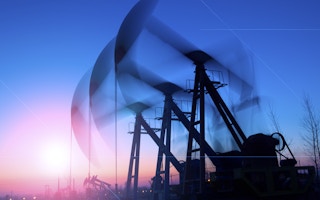On 20 April, the West Texas Intermediate (WTI) oil futures contract for May 2020 delivery defied logic and settled for the first time ever in negative territory at minus-US$37.63 a barrel.
To continue reading, subscribe to Eco‑Business.
There's something for everyone. We offer a range of subscription plans.
- Access our stories and receive our Insights Weekly newsletter with the free EB Member plan.
- Unlock unlimited access to our content and archive with EB Circle.
- Publish your content with EB Premium.
This was after an unprecedented fall in world aviation fuel consumption by 64.3 per cent so far for the month of April and, more importantly, a 32.8 per cent decrease in fuel consumption by cars and trucks around the world for the same period.
Facing the sudden contraction of the market, oil companies are producing a surplus of barrels and must now pay to get rid of their inventories.
After five to seven weeks of global lockdown, with air traffic down 97.1 per cent in Singapore, 94.5 per cent in Hong Kong, 91.7 per cent in France and 83.7 per cent in Australia, airline bail-outs are springing up all over Asia and Europe—Virgin Australia, Thai Airways, Air France-KLM and Korean Air, to name a few.
Refineries are the first of the fossil fuel supply chains to shut down. In Asia, home to more than a-third of global refining capacity, India’s top refiner Indian Oil Corp (IOC) said in a letter to crude suppliers that it had reduced its operations by up to 40 per cent because of sliding demand.
Operators in Japan, South Korea and Thailand—already running at reduced rates—are looking at more cuts even as they shut plants for maintenance.
According to consultancy firm Rystad Energy, given the oil market oversupply, as of today the market may only have around five days left of practical onshore storage capacity for crude oil worldwide, including two million barrels per day (bpd) additional storage in tankers anchored at sea.
The International Energy Agency (IEA) estimates low sulphur fuel oil (LSFO) or fuel oil components to be already seven to eight million tons in floating storage around the larger Singapore area. Last week, major Singapore oil trader Hin Leong Trading collapsed with US$3.85 billion in debts and US$800 million in hidden losses. This could only be the beginning.
As the crude oil market is expected to be in oversupply of 21 million bpd during the second quarter, the 10 million bpd production cut announced by OPEC+ for 1 May will not be large enough to avoid the market hitting physical storage constraints and the WTI future price to be possibly negative again.
If this unfolding energy crisis follows the economic textbooks, a classic boom-bust cycle will take place with the oil industry cutting all investment for several years until demand meets production again.
Offshore exploration should be cut first, then oil sands, shale oil and tight gas, followed by the most extreme onshore locations. Millions of jobs will be gone, financial losses for banks and investors will be massive until the next upswing.
Anyone who can remember the year 2007 might remember that oil prices crossed US$80/barrel in November that year to hit an all-time high of US$143.68/barrel in July 2008, propelling the Toyota Prius hybrid to its best year ever (180,000 cars sold in the United States alone) and spurring some panic investments by oil companies in renewable energy (M&A volumes top only reached again in 2012). The peak oil theory, which postulated the point at which the world’s oil production go into irreversible decline, made headlines and advanced economies were envisioning a post-oil world.
Twelve years and one fracking technology revolution later, the words of former Saudi oil minister Sheikh Yamani on the fate of oil seem to be more valid than ever. He said: “The Stone Age didn’t end for lack of stone, and the oil age will end long before the world runs out of oil.”
How can the world economy be still running on a commodity that is so unpredictable and volatile?
Even without taking into consideration the environmental impact of its extraction (regular offshore spills, shale contamination of potable water and pipeline leaks) and its burning (air pollution, global warming, ocean acidification), the economic cycles linked to its utilisation are far from supporting sustainable development, rational long-term capital utilisation and even peace in this world.
Compared to the regular economic and political chaos brought by fossil fuels, renewable energy sources are the exact opposite. Solar, wind and hydropower are the only ones to warrant a fixed selling price on 25 to 30 years, most of the time non-inflation linked.
Their distributed and local nature reinforce each country’s energy independence, nullifying any Blue Stream, North Stream Pipeline or Belt & Road diplomacy. In open tenders, wind and solar are now the lowest-cost energy providers without subsidies in Western countries and China. The world after has already begun to be built by the power sector.
With their wildly fluctuating prices, oil and liquefied natural gas—with or without the pandemic, with or without geopolitical tensions—cannot be the foundation of 21st-century world economic activity. The current situation is demonstrating oil’s unreliability. Alternatives are readily available: Wind, hydro, and solar energy offer an unbeatable power price stability for 25 years, without air and water pollution, and without global warming impact.
With transport-linked oil consumption expected by Rystad Energy to be down around 24 per cent in the United States and Europe in Q2 after a plunge of 25 per cent in China in Q1, the current oil demand and pollution situation could be a fast-forward image of the world when electric cars are finally mainstream.
BloombergNEF, Bloomberg’s primary research service that covers clean energy, advanced transport and commodities, estimates that electric cars could represent 35 per cent of global new car sales by 2040. The current level of air pollution improvement—PM2.5 levels this month are down 60 per cent in New Delhi, 54 per cent in Seoul and 51 per cent in Los Angeles—could be easily replicated in a future with mass deployment of electric cars fueled by renewable energy.
Blue skies in large metropolises could be the norm again, and transportation users will even save costs by cleaning dirty air. This is the post-oil world that needs to be built.
Olivier Duguet is chairman and chief executive officer at Singapore-based renewable energy company The Blue Circle.









